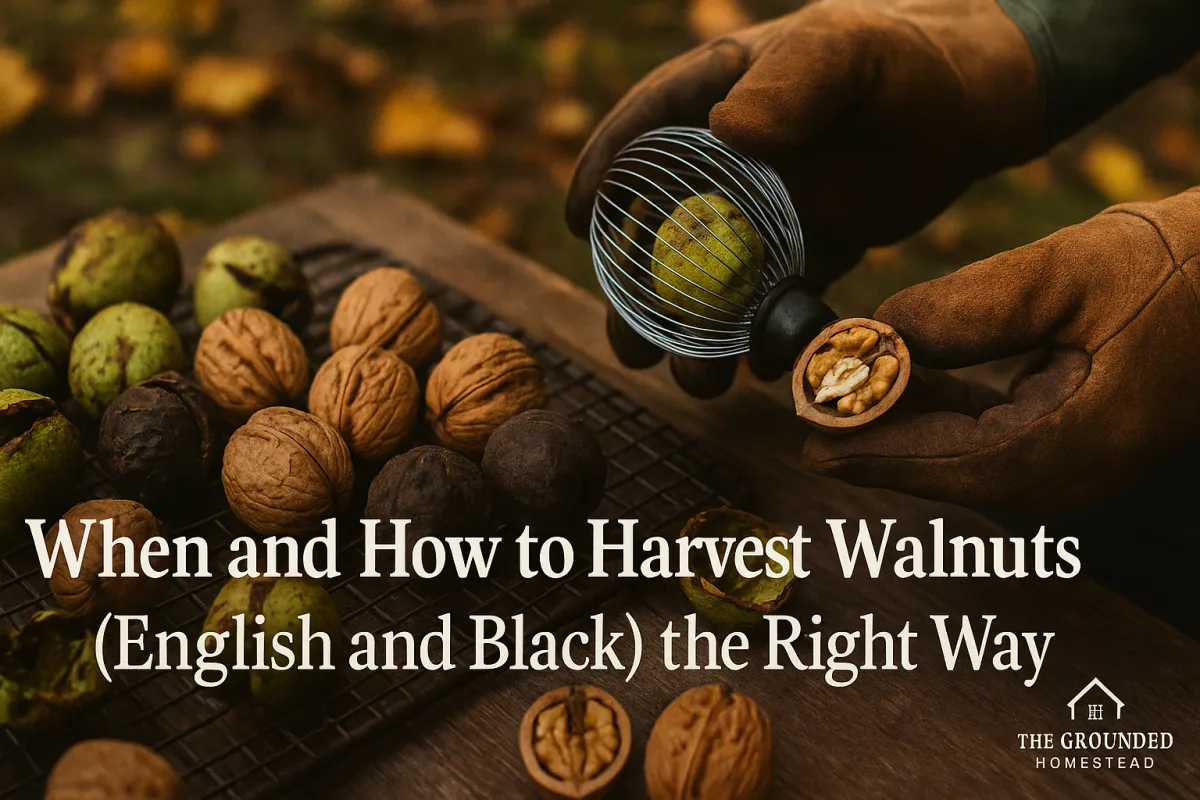
When and How to Harvest Walnuts (English and Black) the Right Way
When and How to Harvest Walnuts (English and Black) the Right Way
The Year We Missed the Harvest
The first year on this property, I thought walnuts would politely wait for me. The trees were loaded, husks still green, and I figured I had time. A week later, I walked out to find mushy black husks littering the ground — and the squirrels had already hauled off the best ones. Lesson learned: walnuts wait for no one.
If you want a good crop, you’ve got to be ready when the husks start splitting — and you’ve got to work quick. Here’s how I harvest both English and black walnuts without staining everything I own.
How to Know When Walnuts Are Mature
Watch the Husk
Mature walnuts signal their readiness when the outer husk begins to split. For English walnuts, the green husk will crack and the nut will fall easily with a shake of the branch. Black walnuts are similar but tend to hold on a little tighter.
Timing by Variety
English (Persian) Walnuts: Typically ripen first, mid-September in most USDA Zones 5–7.
Black Walnuts: Run about 1–2 weeks behind. In my Zone 5b climate, they peak in late September through early October.
Shake Test
Grab a branch and give it a firm shake. If several nuts drop, the tree is telling you it’s go-time.
Best Practices for Gathering Walnuts
Walnut harvest is a daily job — especially if you have squirrels nearby.
Collect Daily: Fallen nuts left more than a day risk mold or becoming wildlife snacks.
Use the Right Tools: A bucket and heavy gloves are fine for a small tree. For a big harvest, I like a rolling wire nut gatherer — saves the back.
Safety Tip: Husks can be slippery. Wear boots with good traction and avoid concrete unless you want green stains.
Husking Without the Green Mess
Walnut husks are notorious for staining everything from hands to driveways. Here’s how I keep it manageable:
Glove Up: Use thick rubber or leather gloves.
Stomp Method: Lay the nuts on gravel and gently step to split the husks.
Car Tire Method: Spread nuts on a tarp, slowly drive over them, then collect.
Dedicated Tools: A simple husking tool or drill-mounted paint mixer can pop husks off quickly.
Pro Tip: Never do this on concrete unless you don’t care about permanent black stains. Cardboard or plywood makes a great work surface.
Washing, Curing, and Drying
Wash Immediately
After husking, hose off any remaining pulp. A stiff brush helps with stubborn spots.
Cure in a Single Layer
Spread walnuts out in a single layer on a screen or drying rack where air can circulate. A shaded porch or barn loft works great. Avoid direct sunlight — too much heat can crack shells or damage the oils.
Curing Time:
English walnuts: 7–10 days
Black walnuts: 10–14 days
You’ll know they’re ready when they feel light and the kernel rattles when shaken.
Storing Walnuts Long-Term
In-Shell Storage
Keep cured nuts in mesh bags, baskets, or crates in a cool, dry spot (ideally 32–45°F). Properly cured, they’ll last 6 months or more.
Shelled Storage
For maximum freshness, shell and store kernels in airtight containers:
Refrigerator: Good up to 6 months.
Freezer: Can last over a year without going rancid.
Avoid the Pantry: Warm storage speeds up rancidity — you’ll taste it as bitterness.
Grandma’s Tip
“If the squirrels are getting them before you, it’s time to get busy!”
She’s right — walnut harvest is one of those tasks you can’t put off.
Common Mistakes to Avoid
Waiting Too Long: Husk rot leads to dark, bitter kernels.
Drying in Direct Sun: Can overheat nuts and cause shells to split.
Skipping Gloves: Walnut husk stain takes weeks to fade from skin.
Faith Tie-In
There’s a rhythm to the harvest that reminds me of Ecclesiastes 3:1 — “To everything there is a season, a time for every purpose under heaven.” The walnuts remind me that if I do the work in season, the reward is waiting — but only if I’m faithful with the timing.
Your Next Step
Go out and check your trees today. Gather a bucketful, try husking a few right away, and see how close you are to the perfect harvest window.
📄 Download the Walnut Harvest & Storage Checklist (free printable) to keep your process organized — from the first nut you pick up to the last one you put in storage.


Facebook
Instagram
X
Youtube